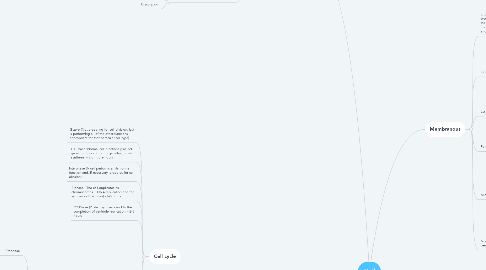
1. Plasma Membrane (outer membrane of the cell, semi permeable barrier, outer membrane of cells)
1.1. Membrane lipids
1.1.1. Phospholipid
1.1.1.1. Hydrophillic head
1.1.1.2. Hydrophobic tail
1.1.2. Cholesterol (critical for membrane fluidity)
1.2. Membrane proteins (anchoring, recognizing, enzymes, receptors, channels, carriers)
1.2.1. Intergral proteins
1.2.2. Peripheral proteins
1.3. Membrane Carbohydrates (present outside of cell membrane and forming coating called Glycocalyx)
1.3.1. Proteoglycans
1.3.2. Glycoproteins
1.3.3. Glycolipids
2. Cell cycle
2.1. G-zero (Not preparing for cell division, but is performing all of the other functions appropriate for that particular cell type)
2.2. G1 Phase (Normal cell functions plus cell growth, duplication of organelles, protein synthesis) - 8 or more hours
2.3. Interphase (A cell performs all its normal function and, if necessary, prepares for cell division)
2.4. S phase ( The cell duplicates its chromosomes - DNA replication and the synthesis of histones) - 6-8 hours
2.5. G2 Phase (Protein synthesis and to the completion of centriole replication) - 2-5 hours
2.6. M Phase
2.6.1. Mitosis (Divides duplicated DNA into 2 sets of chromosomes) - 1-3 hours
2.6.1.1. Prophase
2.6.1.1.1. Nucleoli disappear
2.6.1.1.2. Centriole pairs move to cell poles
2.6.1.1.3. Microtubules extend between centriole pairs
2.6.1.1.4. Nuclear envelope disappears
2.6.1.1.5. Spindle fibers attach to kinetochore
2.6.1.2. Metaphase
2.6.1.2.1. Chromosomes align in a central plane
2.6.1.3. Anaphase
2.6.1.3.1. Microtubules poll chromosomes apart
2.6.1.3.2. Daughter chromosomes group near centrioles
2.6.1.4. Telophase
2.6.1.4.1. Nuclear membranes reform
2.6.1.4.2. Chromosomes uncoil
2.6.1.4.3. Nucleoli reappear
2.6.1.4.4. Cell has 2 complete nuclei
2.6.2. Cytokinesis
2.6.2.1. Division of cytoplasm
2.7. Meiosis
2.7.1. Cell division used to form egg and sperm cells
3. Membranous
3.1. Endoplasmic reticulum (Modify peptide proteins; synthesis of carbohydrates; lipids storage; synthesizing molecules and materials; transport of materials with in ER; and detox drugs, or toxins)
3.1.1. Smooth ER
3.1.1.1. Involve in lipid synthesis, biotransformation and Calcium storage
3.1.1.2. Detoxifying chemical products
3.1.2. Rough ER (Active in proteins and glycoproteins synthesis)
3.1.2.1. Surface covered with Fixed Ribosomes
3.1.2.2. Folds polypeptide protein structures; enclose products in transport vesicles
3.2. Golgi Aparatus
3.2.1. Vesicles enter forming face and exit maturing face
3.2.2. Modify and package secretions; package of special enzymes with in vesicles for use in cytoplasm
3.2.3. Renew or modify plasma membrane
3.3. Lysosomes
3.3.1. Enzyme containing vesicles
3.3.2. Clean up inside cell
3.3.3. Autolyis
3.4. Peroxisomes
3.4.1. Enzyme containing vesicles
3.4.2. Break down fatty acids, organic compounds, produce H2O2
3.4.3. Replicate by division
3.5. Mitochondria
3.5.1. Smooth outer membrane and inner membrane with cistae
3.5.2. Take Glucose to make ATP
3.5.3. Anaerobic metabolism: Glycolysis
3.5.4. Aerobic metabolism: Citric Acid cycle
3.5.5. Electron transport chain
3.6. Nucleus (largest organelle; cell control center)
3.6.1. Envelope: double Phospholipid bilayers
3.6.2. Perinucleus space: between double phospholipid bilayers
3.6.3. Pores: communication passage
4. Nonmembranous
4.1. Cytoskeleton (Structural protein for shape and strength)
4.1.1. Microfilaments
4.1.1.1. Composed of protein actin (Pair with thick filaments myosin for muscle movements)
4.1.2. Intermediate Filaments (Strengthen cells and maintain shapes)
4.1.3. Thick Filaments
4.1.3.1. Composed of protein myosin (Pair with thin filaments actin for muscle movements)
4.1.4. Microtubules (Strengthen cells and anchor organelles; change cell shape; move vesicles with in cell; form spindle apparatus)
4.1.4.1. Made of Tubulin
4.2. Microvilli (Increase surface area for absorption)
4.2.1. Attach to cytoskeleton
4.2.2. Made of microfilaments covered by plasma membrane
4.3. Centrosome
4.3.1. Centrioles (Move toward cell poles during mitosis)
4.3.1.1. 9 sets of triplet microtubules
4.4. Cilia (Move fluid across cell surface)
4.4.1. Composed of Microtubules
4.4.1.1. Made of Tubulin
4.5. Ribosomes (Site of polypeptide/protein synthesis)
4.5.1. Free Ribosomes (Protein for in-cell (cytosol) use)
4.5.1.1. Floating in cytoplasm
4.5.2. Fixed Ribosomes (Protein for secretion)
4.5.2.1. Attached to rough ER
4.6. Proteasomes (Disassemble damaged proteins for recycling)
4.6.1. Contain Enzymes Protease

